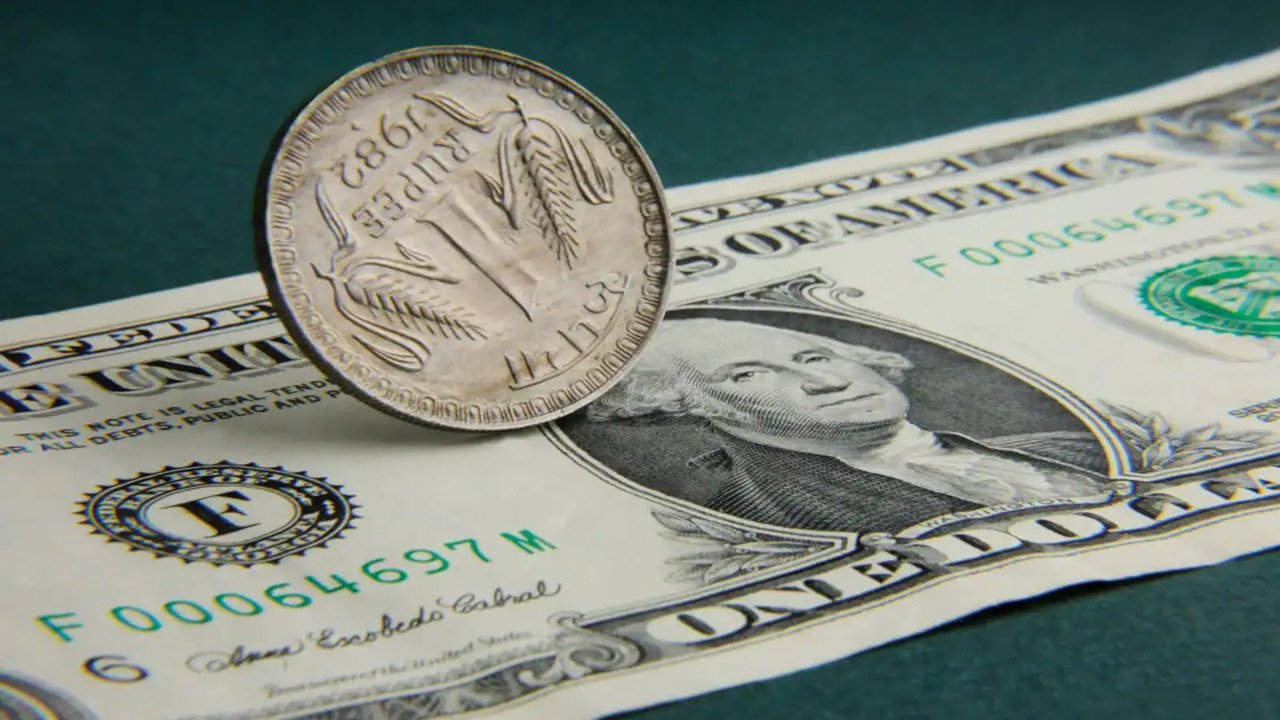Rupee hits all-time low of against U.S. dollar in 2025.
Rupee hits all-time low of against U.S. dollar In 2025, the Indian rupee (INR) reached a historic low, breaching the 88 mark against the U.S. dollar (USD), with a record closing rate of 88.19 on September 1, 2025, as reported by The Hindu and LiveMint. This milestone, following a consistent decline from 84.38 in November 2024 to 88.33 intra-day on August 29, 2025, reflects a confluence of global and domestic economic pressures. The rupee’s depreciation, accelerating at a rate of nearly 4% since October 2024, has sparked concerns about inflation, trade deficits, and India’s economic competitiveness.
Thank you for reading this post, don't forget to subscribe!This article examines the reasons behind the rupee’s all-time low, its implications for the Indian economy and citizens, and actionable strategies to navigate this financial landscape, supported by a detailed table summarizing key factors and their impacts.
Rupee hits all-time low of against U.S. dollar Causes of the Rupee’s Depreciation in 2025
The rupee’s decline to an all-time low against the USD in 2025 stems from a mix of global economic dynamics, domestic challenges, and policy shifts.
1. U.S. Tariff Policies
The imposition of steep U.S. tariffs under the Trump administration has significantly pressured the rupee. In August 2025, Washington doubled duties on Indian exports to 50%, compared to 30% on Chinese goods, sparking fears of a trade war (Business Today, August 29, 2025). These tariffs, targeting sectors like textiles and engineering goods, reduced India’s export competitiveness, increasing dollar demand and weakening the rupee to 88.33 intra-day (LiveMint, September 1, 2025).
2. Strong U.S. Dollar and Federal Reserve Policies
The U.S. dollar index (DXY) hit a two-year high of 109.80 in January 2025, driven by robust U.S. economic data, including 256,000 jobs added in December 2024, far exceeding expectations (India Today, January 13, 2025). The Federal Reserve’s hawkish stance, with diminished prospects of rate cuts in 2025, bolstered the dollar, pushing the rupee to 87.95 by February 10, 2025 (The Hindu, February 10, 2025). Higher U.S. Treasury yields (4.79% in January) further attracted capital away from emerging markets like India.
3. Rising Crude Oil Prices
India’s heavy reliance on imported crude oil, accounting for 80% of its needs, exacerbates rupee depreciation. Rupee hits all-time low of against U.S. dollar Brent crude prices surged to $80.65 per barrel in January 2025, driven by U.S. sanctions on Russia and Middle East tensions (The Hindu, January 13, 2025). This increased India’s import bill, raising dollar demand and contributing to the rupee’s fall to 86.39 (India Today, January 13, 2025).
4. Foreign Institutional Investor (FII) Outflows
Persistent FII outflows have strained India’s foreign exchange reserves. In November 2024, FIIs sold $1.5 billion in Indian equities, following $11 billion in October (CFO News, November 7, 2024). By August 2025, outflows reached ₹8,312.66 crore in a single day (The Hindu, September 1, 2025). These withdrawals, triggered by global uncertainties and tariff fears, reduced dollar supply, pushing the rupee to its lowest levels.
5. Widening Trade Deficit
India’s trade deficit widened due to higher imports outpacing exports. In 2025, imports of crude oil and other essentials grew, while exports struggled under U.S. tariffs (blog.bullsmart.in, August 21, 2025). This imbalance increased dollar demand, contributing to the rupee’s decline to 87.07 by February 3, 2025 (India Today, February 3, 2025).
6. RBI’s Monetary Policy and Reserves
The Reserve Bank of India (RBI) has allowed controlled rupee depreciation to boost export competitiveness, with Governor Sanjay Malhotra stating the focus is on medium-to-long-term stability (The Hindu, February 10, 2025). However, forex reserves dropped by $4.386 billion to $690.72 billion by August 22, 2025, limiting RBI’s intervention capacity (The Hindu, September 1, 2025). Anticipa
Table: Key Factors Driving Rupee’s Depreciation in 2025
| Factor | Description | Impact on Rupee | Economic Consequence |
|---|---|---|---|
| U.S. Tariffs | 50% duties on Indian exports, effective August 2025 | Increased dollar demand, rupee fell to 88.33 | Reduced export competitiveness, trade deficit |
| Strong U.S. Dollar | DXY at 109.80, Fed’s hawkish policy, high Treasury yields (4.79%) | Rupee weakened to 87.95 by February 10 | Capital outflows, higher import costs |
| Rising Crude Oil Prices | Brent crude at $80.65/barrel due to geopolitical tensions | Contributed to rupee’s fall to 86.39 | Higher import bills, inflation risk |
| FII Outflows | ₹8,312.66 crore sold on August 29, 2025; $1.5B in November 2024 | Rupee hit 88.19 closing low | Reduced forex reserves, market volatility |
| Widening Trade Deficit | Imports outpaced exports, driven by oil and tariff impacts | Rupee dropped to 87.07 by February 3 | Increased dollar demand, economic strain |
Notes:
Exchange Rates: Reflect record lows reported in 2025.ted rate cuts in February 2025 further weakened the rupee to 87.57 (The Hindu, February 6, 2025).
Impacts of the Rupee’s Depreciation

The rupee’s fall to 88.19 against the USD has far-reaching consequences for India’s economy and its citizens:
1. Inflation and Cost of Living
A weaker rupee increases the cost of imported goods, such as oil, electronics, and raw materials, fueling inflation. India Today (January 13, 2025) notes that higher import costs could push India’s retail inflation, already at a low 8-year level, upward, affecting essentials like fuel and food. Rupee hits all-time low of against U.S. dollar For consumers, this means higher prices for groceries and imported products, with electronics like laptops costing 4-6% more.
2. Trade and Export Dynamics
While a depreciating rupee makes Indian exports cheaper, U.S. tariffs offset this advantage, particularly in textiles and chemicals (Business Today, August 29, 2025). However, sectors like IT and pharmaceuticals may benefit, as a weaker rupee increases export earnings in INR terms (HDFC Bank, 2025). Rupee hits all-time low of against U.S. dollar India’s trade deficit with China could narrow, as the rupee’s 6% decline against the yuan makes Indian goods more competitive (Business Today, August 29, 2025).
3. Corporate and Investor Impact
Companies with dollar-denominated debt face higher repayment costs, straining finances. Conversely, export-oriented firms like TCS and Sun Pharma may see profit boosts. Rupee hits all-time low of against U.S. dollar Domestic stock markets, however, have slumped, with the BSE Sensex dropping 1,048.90 points on January 13, 2025, due to tariff fears and FII outflows (The Hindu, January 13, 2025).
4. Household Finances
For individuals, a weaker rupee increases the cost of international travel, education, and remittances. Studying abroad now requires 4% more INR for the same USD expenses (appreciatewealth.com, July 9, 2025). However, NRIs remitting dollars to India benefit, as their funds convert to more rupees.
5. Economic Growth Concerns
The rupee’s rapid depreciation threatens India’s nominal GDP growth in USD terms, potentially undermining goals like surpassing Japan’s GDP by 2025 (Reddit, January 15, 2025). Analysts predict the rupee could hit 90 INR/USD in the near future, further complicating economic targets (Reddit, January 15, 2025).
Strategies to Navigate the Rupee’s Depreciation
Individuals and businesses can adopt several strategies to mitigate the impact of the rupee’s fall:
1. Diversify Investments
Invest in dollar-based assets like U.S. ETFs or gold to hedge against rupee depreciation. Gold, a safe-haven asset, protects against currency volatility (appreciatewealth.com, July 9, 2025). Allocate 10-15% of portfolios to such assets to balance risk.
2. Focus on Export-Oriented Sectors
Investors can target Indian companies in IT, pharmaceuticals, and textiles, which benefit from a weaker rupee. Stocks like Infosys or Dr. Reddy’s Laboratories may see gains (HDFC Bank, 2025).
3. Manage Foreign Currency Needs
Importers and travelers should use forward contracts to lock in exchange rates, reducing exposure to further rupee declines. Hedging can save 2-3% on large transactions (EBC Financial Group, August 8, 2025).
4. Boost Domestic Consumption
Households can reduce reliance on imported goods by choosing local alternatives, mitigating inflation’s impact. For example, opting for Indian-made electronics can save 5-10% on costs.
5. Monitor RBI Interventions
Stay informed about RBI’s forex interventions and rate decisions, as these can stabilize the rupee. The RBI’s use of $690.72 billion in reserves in August 2025 indicates active management (The Hindu, September 1, 2025).
Public and Media Sentiment
Media outlets like The Hindu, India Today, and Business Today highlight the rupee’s decline as a pressing issue, attributing it to tariffs, dollar strength, and oil prices. On X, posts reflect mixed sentiments: @Akshat_World predicts the rupee could hit 110 INR/USD in five years, signaling pessimism, while @rishibagree praises India’s resilience through tax reforms and S&P upgrades (X, August 18, 2025). Public concern centers on inflation and economic goals, with Reddit users noting the impact on India’s GDP aspirations (Reddit, January 15, 2025).
RBI’s Role and Future Outlook
The RBI has intervened by selling dollars to cap the rupee’s fall, but dwindling reserves limit aggressive action (Reuters, August 30, 2025). Analysts from Bechtel and ANZ Bank predict the rupee could weaken to 88 by March 2025 (India Today, January 13, 2025). Rupee hits all-time low of against U.S. dollar Long-term strategies, such as boosting FDI and remittances, are crucial for stabilization (nextias.com, January 14, 2025). India’s manufacturing sector growth in August 2025 offers some optimism (The Hindu, September 1, 2025).
Conclusion
The Indian rupee’s all-time low of 88.19 against the U.S. dollar in 2025 reflects global pressures like U.S. tariffs, a strong dollar, and rising oil prices, compounded by domestic challenges like FII outflows and trade deficits. While this depreciation fuels inflation and strains household budgets, it also presents opportunities for exporters and NRIs. Rupee hits all-time low of against U.S. dollar, By diversifying investments, hedging currency risks, and supporting domestic consumption, individuals and businesses can navigate this challenging landscape. The RBI’s interventions and India’s economic reforms provide a foundation for resilience, but sustained efforts to attract FDI and boost exports are critical to stabilizing the rupee and ensuring financial stability in 2025.













